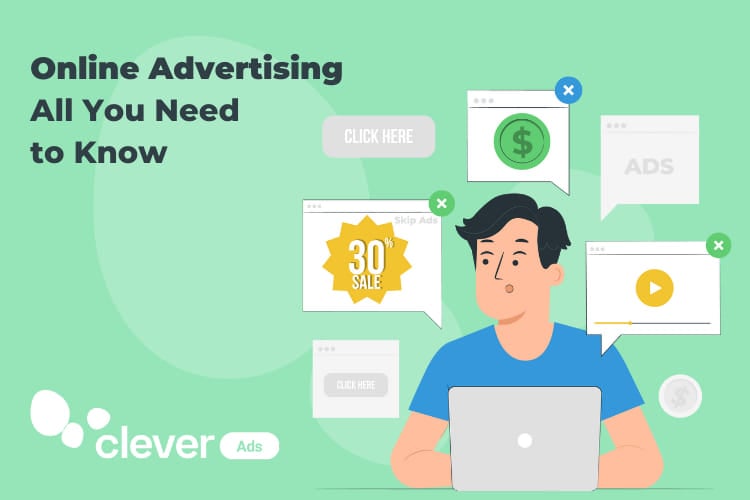Online Advertising – All You Need to Know
Online advertising might be confusing with many online advertising platforms, campaigns, and ad types, and even targeting capabilities popping up all the time.
In this article, you will learn everything you need to know about online advertising including paid search, display, social media, and native advertising. You’ll also learn how paid and organic marketing strategies are closely related, and that online advertising can help you improve your organic results.
We recommend you check Clever Ads online advertising tools for automating the creation, optimization, and management of your online advertising strategies.
How can online advertising help you improve your organic results?
Paid and organic strategies are commonly managed by different teams with different goals. While organic marketing focuses on building communities, sharing content, or organic keyword optimization, online advertising focuses on metrics like ROAS or CPAs.
However, in the end, the purpose of both strategies is the same: bringing profitable traffic to your site. Let’s see how both strategies can work together:
- Testing different online advertising copies and learning about the ones that are working better in your ad strategy can help you create higher-performing content in your organic marketing strategies (blog, social media, site content…). It also works the other way around.
- Online advertising strategies can help you boost your brand awareness fast by displaying your brand and content to wider audiences that wouldn’t have been possible to reach organically.
- You can reach a better understanding of your audiences thanks to the analytics and targeting data from the ads platforms. Organic analytics can also help you get insights that might be useful when planning and configuring your online advertising strategies.
Calculate your online advertising spend to get the most return on your investment.
Or said in other words, how to maximize your ROAS when planning your online advertising budget?
First, let’s understand how the advertising platforms (Google Ads, Facebook Ads, Microsoft Ads, etc.) bidding system is managed. Their bidding system works basically like an auction in which all the advertisers determine how much they are willing to pay for showing their ad to people for a specific search query.
However, the ad platforms won’t only take into account how much you’re willing to pay but also your ad quality score. Both things together will determine your ad rank and so how your ad will be positioned and displayed on the different ad platforms results page.
Max Bid x Quality Score = Ad Rank = Position
Then, having this clear, how can you know how much to spend on your online advertising strategies in order to maximize your ROAS?
- Calculate your clients’ lifetime value, meaning an average of how much a customer is worth to you over the whole relationship with your business.
- Calculate your conversion rate, meaning the percentage of leads that become customers or that perform the goal action you set when planning your online advertising strategy.
Lifetime Value x Average Conversion Rate
The result will be the maximum ad spend you should invest to neither win or lose money. So ideally your ad spend should be lower than that maximum amount.
Online Advertising Types
In this article we’ll review the following 4 types of online advertising strategies:
- Paid Search advertising, focusing on Google Ads.
- Display advertising, including Google display network and Facebook audience network.
- Social Media Advertising: Facebook Ads, Instagram Ads, Twitter Ads, LinkedIn Ads, Twitter Ads, YouTube Ads, Snapchat Ads, Tik Tok, and Pinterest Ads.
- Native advertising.
Paid Search Advertising
Let’s start with why you should advertise to appear on the first page of search engine results even though you have a good organic positioning:
- Search Ads appear above the organic results, so if you want to assure you get the first position the only option is to invest some money in paid search advertising.
- Competitors might bid for your brand name which means they could be advertising to appear on top of you for people searching for your brand. The only way to prevent this is to bid for your keywords yourself. It’s a really cheap option because your quality score will always be really high for your brand and so you won’t need high bids to reach the first position.
- If done correctly it’s a very profitable strategy. For example on Google, on average, advertisers make $8 for every dollar spent on Google Ads.
- Paid search advertising allows capturing people’s attention in a more targeted way as you can use people’s interests and needs to build specific ad copies for them.
And how can you deliver the right ads to the right audience with paid search advertising strategies? Through the keywords to bid for.
You can build specific ads and ad copies for specific keywords or search queries. This way your ads will match the searchers’ intent and you’ll be able to adapt your ads to people’s specific needs at the right moment they are searching for what you offer.
You can create ad groups to target small sets of keywords for which Google, Microsoft, or other search engines will display your customized ads for those keywords.
On the Clever Ads blog, we have several articles so you can learn more about how to do a keyword research for your online advertising strategies. We also have a keyword planner for you to use during your keyword research.
Display Advertising
This type of advertising is great for reaching large audiences and boosting your awareness, as you can reach people when they are navigating their favorite sites.
You won’t reach them right when they are searching for things related to your business, meaning the audience normally won’t be as qualified as the one from the search network. However, if well configured you can still reach high-intent audiences and have an awesome performance.
The “dark side” of display advertising is people developed banner blindness due to bad practices performed in the past, as well as the rise of ad blockers. Most people use them because display ads have a bad reputation for being distracting, intrusive, and irrelevant.
Anyway, as previously stated, technology has evolved and display advertising is now able to reach more qualified audiences, you can even choose where exactly you want to place your banner ads.
There are different networks that offer different targeting options and features:
- Google Display Network: It allows you to build new audiences by targeting people with different levels of interest in your products or services, and retarget people that already know you because they have visited your site or performed any action there. You can use our Google Ads Creator for having your Google Display ads automatically created.
- Facebook Audience Network: Advertisers can use the same targeting data they use on the platform to advertise on a lot of websites and mobile apps. Actually, this type of ad is quite effective for mobile games.
Social Media Advertising
Customers and potential clients spend hours on social media for different purposes: chatting with friends, staying connected, networking, or doing business, which makes social media platforms a great place to find and target your audience.
With social media advertising you can:
- Select the ad efforts that drive leads and sales specifically for your business.
- Create ads online in many formats to advertise in a way that aligns with your goals.
- Reach specific target audiences across social media platforms.
The most popular social media advertising platforms are Facebook Ads, Instagram Ads, Twitter Ads, LinkedIn Ads, Twitter Ads, YouTube Ads, Snapchat Ads, Tik Tok, and Pinterest Ads.
Native Advertising
Native advertising consists of brands paying publishers to distribute their sponsored content to their audience on their website and social media channels.
Each publisher will support different ad formats and creative types depending on their site and preferences, and you’ll work directly with them so your content matches their site and their own brand personality.
This is why this type of online advertising doesn’t always look like it, some people won’t even notice its advertising as it might look like a regular piece of content on the publishers’ website.
Actually, it’s normally a win-win situation for both the advertiser and the publisher, let’s check the data:
- More than 40% of readers say their trust in publishers increases when they publish with a trustworthy brand.
- More than 30% of readers say they’re more likely to buy from a brand after viewing their native ad.





